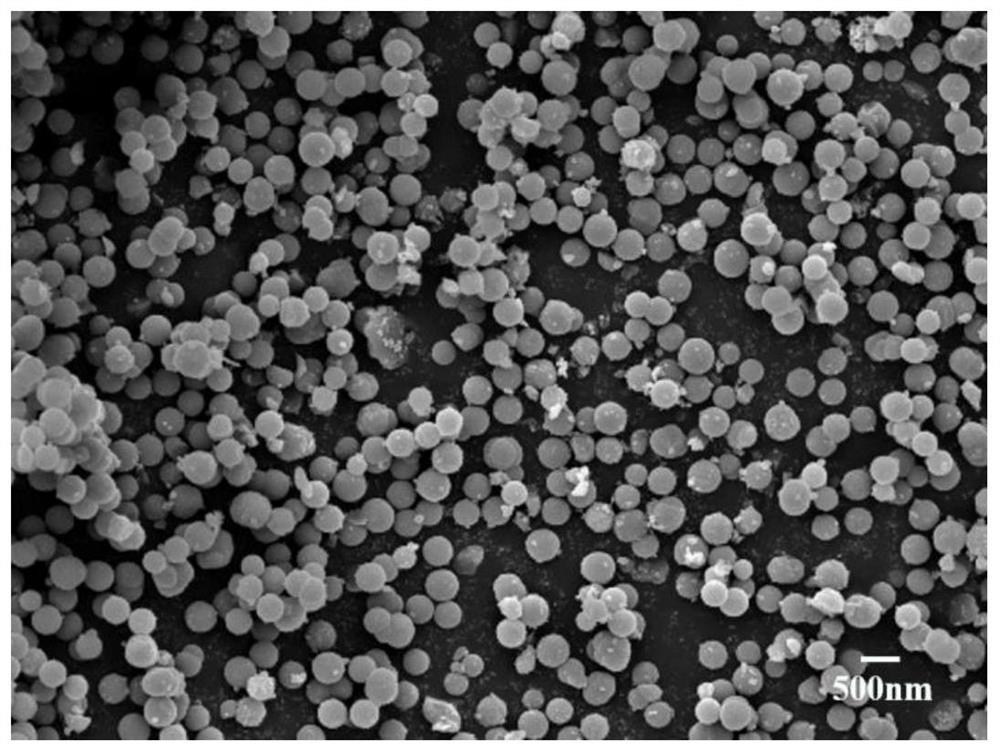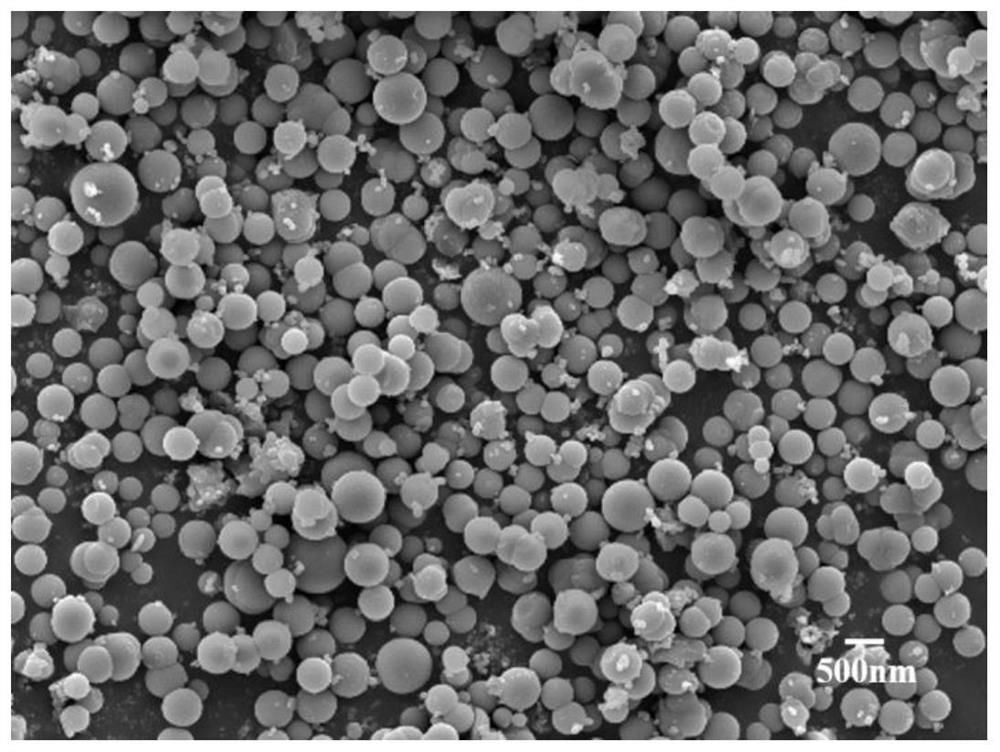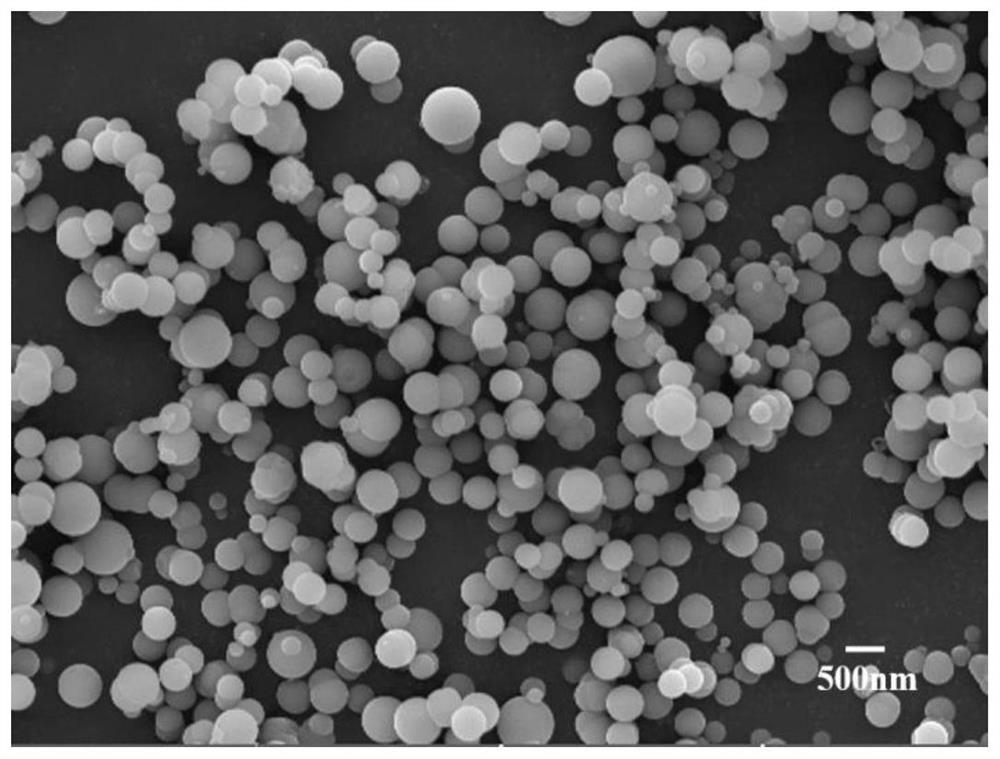A method for synthesizing metal oxide microspheres based on the Stober method
A metal alcoholate and oxide technology, which is applied in the field of metal oxide microspheres based on the Stober method, can solve the problems of not meeting the basic requirements of sol-gel, fast hydrolysis, polydispersity and even agglomeration, and achieve microsphere Controllable nanoparticle size, not easy to agglomerate, and uniform size
- Summary
- Abstract
- Description
- Claims
- Application Information
AI Technical Summary
Problems solved by technology
Method used
Image
Examples
Embodiment 1
[0031] Under anhydrous conditions, 0.3 g of tetra-n-butyl titanate was added to 10 mL of ethylene glycol, and the reaction was fully stirred to form a stable precursor solution. 0.55 mL of ethanol and 0.45 mL of glacial acetic acid were added to the obtained precursor solution, and Add 0.5 g of N-sulfonic acid butylpyridinium bisulfate, fully disperse and dissolve and stir for 0.5 h, and finally add 20 mL of acetone to it, stir and mix evenly to obtain a reaction solution. The prepared reaction liquid is packed in a high-pressure container, and heated to 120°C, fully reacted for 3 h, centrifuged the final reaction liquid after the reaction, centrifuged at 2000 rpm for 30 min to obtain solid particles, and used ethanol and water at a volume ratio The eluent prepared at 1:3 elutes the solid particles 2 to 3 times, and the separated product is dried in an oven at 80°C for 8h, and then in a tube furnace, air is roasted at 500°C for 10 h, the air flow rate is 3.6 L / min, and titaniu...
Embodiment 2
[0034] Under anhydrous conditions, add 0.45 g of aluminum isopropoxide to 10 mL of ethylene glycol, stir the reaction to form a stable precursor solution, add 0.75 mL of ethanol and 0.55 mL of glacial acetic acid to the obtained precursor solution, and add Add 0.36 g of mixed acid (concentrated sulfuric acid and concentrated nitric acid in a volume ratio of 1:1), fully disperse and dissolve, and stir for 0.8 h. Finally, add 20 mL of acetone to it and mix well to obtain a reaction solution. The prepared reaction solution was packed into a high-pressure container, and heated to 125° C., fully reacted for 3 h, centrifuged the final reaction solution after the reaction, centrifuged at 2000 rpm for 30 min to obtain solid particles, and used ethanol and water at a volume ratio The eluent prepared at 1:2 elutes the solid particles 2 to 3 times, and the separated product is dried in an oven at 90°C for 6 h, and then roasted in air at 450°C in a tube furnace After 10 h, the air flow ra...
Embodiment 3
[0037] Under anhydrous conditions, add 0.38 g of zirconium n-propoxide to 10 mL of ethylene glycol, stir the reaction to form a stable precursor solution, add 0.65 mL of ethanol and 0.55 mL of glacial acetic acid to the obtained precursor solution, and add Add 0.46 g of Hβ molecular sieve, fully disperse and dissolve and stir for 0.8 h, and finally add 20 mL of acetone to it, stir and mix evenly to obtain a reaction solution. The prepared reaction solution was packed into a high-pressure container, and heated to 125° C., fully reacted for 2 h, centrifuged the final reaction solution after the reaction, centrifuged at 5000 rpm for 30 min to obtain solid particles, and used ethanol and water at a volume ratio The eluent prepared at 1:5 elutes the solid particles 2 to 3 times, and the separated product is dried in an oven at 100° C. for 6 hours, and then in a tube furnace, roasted with air at 600° C. for 9 h, the air flow rate is 2.26 L / min, and the zirconia microspheres are obta...
PUM
| Property | Measurement | Unit |
|---|---|---|
| particle diameter | aaaaa | aaaaa |
| particle diameter | aaaaa | aaaaa |
| particle diameter | aaaaa | aaaaa |
Abstract
Description
Claims
Application Information
 Login to View More
Login to View More - R&D
- Intellectual Property
- Life Sciences
- Materials
- Tech Scout
- Unparalleled Data Quality
- Higher Quality Content
- 60% Fewer Hallucinations
Browse by: Latest US Patents, China's latest patents, Technical Efficacy Thesaurus, Application Domain, Technology Topic, Popular Technical Reports.
© 2025 PatSnap. All rights reserved.Legal|Privacy policy|Modern Slavery Act Transparency Statement|Sitemap|About US| Contact US: help@patsnap.com



